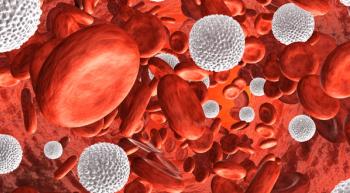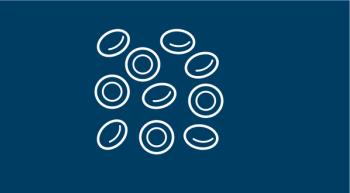
Revumenib Shows Promise in Phase 2 Trial of Children and Adults With R/R KMT2Ar Acute Leukemia
A new targeted therapy showed promising response rates in pediatric and adult patients with relapsed/refractory KMT2A rearranged acute leukemia.
Revumenib garnered durable minimal residual disease (MRD)-negative remissions rates in patients with relapsed or refractory KMT2A rearranged acute leukemia, according to findings from the phase 2 Augment-101 study (NCT04065399), which were presented at the 2023 American Society of Hematology Annual Meeting and Exposition.
Additionally, a high proportion of patients on the trial were able to continue to transplant, which, according to Ibrahim Aldoss, MD, is the goal of treatment in this setting.1
“After achieving a response, 40% of responders were able to go on to allogeneic stem cell transplant, which is usually our ultimate goal for someone with relapsed/refractory leukemia,” Aldoss, who is a hematology oncologist at the City of Hope Comprehensive Cancer Center, explained in the presentation. “Half of the patients were able to continue revumenib as a maintenance therapy after the transplant.”
Further, investigators concluded that the safety profile is promising because the rate of adverse event (AE)-related discontinuations and dose reductions were low. The rate of treatment-emergent AE (TEAE)-related discontinuation was 6%.
Key Efficacy Data
At a median follow-up of 6.1 months, the rate of overall response in the efficacy population (n = 57), was 63% (n = 36). This included a 23% complete remission (CR) plus CR with partial hematologic recovery (CRh) rate (95% CI, 12.7-35.8; 1-sided P = .0036), and a 44% composite CR rate (95% CI, 30.7-57.6). The median duration of remission was 6 months.
Regarding best response, 10 patients achieved a CR (18%), 3 achieved a CRh (5%), 1 achieved a CR with incomplete hematologic recovery (1.8%), and 11 achieved a CR with incomplete platelet recovery (19%). Ten patients reached a morphologic leukemia-free state (18%), and 1 patient achieved a partial response (1.8%).
Among those with negative MRD status, the CR + CRh rate was 70% (n = 7/10) and the CRc rate was 68% (n = 15/22).
The efficacy population included patients who had a confirmed KMT2A rearrangement and who remainedin follow-up for the prespecified amount of time.Of note, Aldoss also presented findings from a “safety population,” which included all patients who received at least 1 dose of revumenib, regardless of if they had their KMT2A rearrangement confirmed centrally and regardless of follow-up in the trial.
In the efficacy population, 86% of patients had acute myeloid leukemia (AML) and 12% had acute lymphoblastic leukemia (ALL), while 2% had mixed-phenotype acute leukemia or another subtype. The most common co-mutation was RAS (16%), followed by FLT3 (9%), and p53 (7%). A quarter (25%) of these patients had primary refractory disease, and the median number of prior treatment lines was 2 (range, 1-11). Most patients (72%) had received prior venetoclax (Venclexta), and nearly half (46%) had undergone prior hematopoietic stem cell transplantation (HSCT).
“These are heavily pretreated patients,” Aldoss underscored. “Close to half of these patients had at least 3 or more prior lines of therapy, and almost half of the patient had prior allogeneic stem cell transplant.”
The median age in the efficacy population was 34.0 years (range, 1.3-75.0); 13 patients (22.8%) were under the age of 18 and 44 (77.2%) were 18 or older. More patients were female (57.9%), and White was the most represented race (75.4%) in the study.
The trial dose was 163 mg of oral revumenib (or 95 mg/m2 if their body weight was less than 40 kg) every 12 hours, along with a strong CYP3A4 inhibitor in 28-day cycles. All patients enrolled in this trial were at least 30 days or older.
Safety Data
Any-grade nausea (44.7%), febrile neutropenia (38.3%), diarrhea (35.1%), and vomiting (30.9%), were the most common TEAEs reported in the trial. Other TEAS, of any grade, that occurred in at least 25% of patients were differentiation syndrome (27.7%), hypokalemia (27.7%), epistaxis (26.6%), and QTc prolongations (25.5%).
In terms of grade 3 or worse TEAEs, the most commonly reported ones were febrile neutropenia (37.2%), anemia (18.1%), decreased neutrophil count (16.0%), decreased white blood cell count (16.0%), and decreased platelet count (14.9%). Other grade 3 or worse TEAEs, occurring in at least 10% of patients, included differentiation syndrome (16.0%), QTc prolongation (13.8%), sepsis (11.7%), and hypokalemia (10.6%).
Of note, there was no instances of treatment discontinuation related to differentiation syndrome, QTc prolongation, or cytopenias.
Similar to the efficacy population, 83% of patients in the safety population had AML and 15% had ALL, while 2% had mixed-phenotype acute leukemia or another subtype. The most common co-mutation was RAS (13%), followed by FLT3 (7%), and p53 (5%). A fifth (19%) of patients had primary refractory disease, and the median number of prior treatment lines was 2 (range, 1-11). Most patients (65%) had already received venetoclax and half (50%) had undergone prior HSCT.
The median age in this cohort was 37.0 years (range, 1.3-75.0); 23 patients were pediatric (24.5%) and 71 were adults (75.5%). Again, most patients were female (59.6%) and White (72.3%).
Findings in Context
There are currently no approved targeted therapies for patients with KMT2A rearrangements despite it being prevalent in up to 10% of acute leukemias.2
Following chemotherapy and HSCT, most patients will relapse, and the rate of remission following relapse is low (CR, 5%), as is the median overall survival (2.4 months) in adults. The outcomes associated with infants and children after relapse also remain poor.1
“It's a disease with unmet therapeutic need,” Aldoss said. “These patients have high risk of relapse after transplant and after chemotherapy and, in adults, remission rates after relapse—and median overall survival when the patients reach second salvage therapy or beyond—remain low.”
Revumenib inhibits the menin-KMT2A interaction, turning off gene transcriptions, and limiting leukemogenesis. Previous findings from a phase 1 study demonstrated that this agent yielded clinically meaningful responses across various subgroups, while also helping a higher percentage of responders continue to transplant.
The study was stopped early after the primary efficacy end points were met by the predefined interim analysis, but enrollment for the independent NPM1m cohort is ongoing at all sites. NPM1 mutations can occur in up to 30% of acute leukemias.1,2
“In conclusion, revumenib is effective and safe in pediatric and adult patients with relapsed/refractory KMT2A rearranged acute leukemia, and induced durable MRD-negative remission,” Aldoss summarized.
Based on these data, a new drug application for the agent has been submitted to the FDA under the Real-Time Oncology Review program.1
References
- Aldoss I, Issa GC, Thirman M, et al. Revumenib monotherapy in patients with relapsed/refractory acute leukemia topline efficacy and safety results from the pivotal augment-101 phase 2 study. Blood. 2023;142(supple 2): LBA-5. doi:10.1182/blood-2023-192042
- Issa GC, Aldoss I, DiPersio J, et al. The menin inhibitor revumenib in KMT2A-rearranged or NPM1-mutant leukaemia. Nature. 2023;615(7954):920-924. doi:10.1038/s41586-023-05812-3
Newsletter
Knowledge is power. Don’t miss the most recent breakthroughs in cancer care.
















































































